

外卖O2O与传统餐饮服务在空间分布上的竞合关系研究:共存、补充抑或替代
|
牛强(1978—),男,湖北宜昌人,博士,教授,博士生导师,研究方向为信息时代的城乡规划、定量城市研究和规划分析,(E-mail)niuqiang@whu.edu.cn。 |
收稿日期: 2023-04-25
修回日期: 2023-06-30
网络出版日期: 2024-06-12
基金资助
国家自然科学基金项目(51778503)
Coopetition between Take-out and Traditional Restaurants in Spatial Distribution: Coexistence, Complementarity, or Substitution
Received date: 2023-04-25
Revised date: 2023-06-30
Online published: 2024-06-12
信息通信技术(ICT)的广泛应用引发城市餐饮业空间格局的变革,致使外卖O2O与传统餐饮服务在空间分布上的竞合关系日趋复杂。文章以武汉都市发展区为例,基于美团外卖、大众点评和联通手机信令数据,运用改进累积机会法和双变量空间自相关模型,从空间分布视角探究外卖O2O与传统餐饮服务的的空间竞合关系及其影响因素。研究发现:1)空间分布上,相较于传统餐饮服务的空间不均衡特征,外卖O2O服务更为均质化,且在近郊区增长更快;2)两者空间分布关系上,外卖O2O与传统餐饮服务整体上存在显著的空间依赖性但关联程度逐渐减弱,局部上在中心城区呈现高-高聚集,在近郊区呈现低-低聚集为主、高-低聚集为辅,反映与区位有明显关联的空间异质性;3)在两者的竞合关系上,中心城区以共存关系为主,近郊区以补充关系为主,替代关系不显著,而人口密度、餐饮店铺数量、地块属性是关键影响因素,共存关系主要存在于人口密度高、这两类餐饮店铺数量多的成熟居住区,补充关系主要存在于人口密度低、外卖店铺数量多且传统餐饮店数量少的居住-工业混合布局地区。

牛强 , 郭艺凯 , 伍磊 . 外卖O2O与传统餐饮服务在空间分布上的竞合关系研究:共存、补充抑或替代[J]. 热带地理, 2024 , 44(8) : 1435 -1448 . DOI: 10.13284/j.cnki.rddl.20230285
The widespread adoption of information and communication technologies has reshaped the spatial dynamics of the catering industry, rendering the coopetition relations between take-out and traditional restaurants in spatial distribution increasingly intricate. Leveraging data from Meituan takeout, Dianping, and Unicom mobile signaling, we utilized the Wuhan metropolitan area as a case study. Employing the improved cumulative opportunity method and the bivariate spatial autocorrelation model, this study delved into the coopetition dynamics between take-out and traditional restaurants in terms of spatial distribution, unveiling the factors influencing these relations. Our research yielded three primary findings. Firstly, from a spatial distribution perspective, traditional catering services display spatial disparities, while take-out online-to-offline (O2O) services exhibit greater homogeneity, particularly proliferating in suburban areas. Secondly, regarding spatial distribution relationships, a significant spatial dependence between takeout O2O and traditional catering services was evident overall, albeit with a gradual weakening of correlation. From a local perspective, the spatial correlation dendrogram reveals that "High-High" coupling prevails as the primary spatial correlation pattern in the central urban area. Conversely, in suburban regions, there is a phenomenon of "Low-Low" clusters as the primary and "High-Low" clusters as the secondary, indicating significant spatial heterogeneity associated with location. Thirdly, concerning the coopetition relationships between take-out and traditional restaurants in terms of spatial distribution, the coexistence relationship dominates in the central urban area, while the complementarity relationship prevails in suburban areas, with the substitution relationship being insignificant in either region. Population density, the number of restaurants, and land attributes significantly impact coopetition relations between take-out and traditional restaurants. The coexistence relationship primarily thrives in mature residential areas characterized by high population densities and a substantial presence of both takeout and traditional restaurants. Conversely, the complementarity relationship predominantly exists in residential industrial mixed-layout areas characterized by low population densities, a significant number of takeout restaurants, and a small number of traditional restaurants.

图3 武汉市外卖O2O(a、b)与传统餐饮(c、d)服务水平的空间分布Fig.3 Spatial distribution of the service level of take-out restaurant (a, b) and traditional restaurant (c, d) in Wuhan City |
| 餐饮店类型 | 2018年 | 2019年 |
|---|---|---|
| 外卖 O2O | 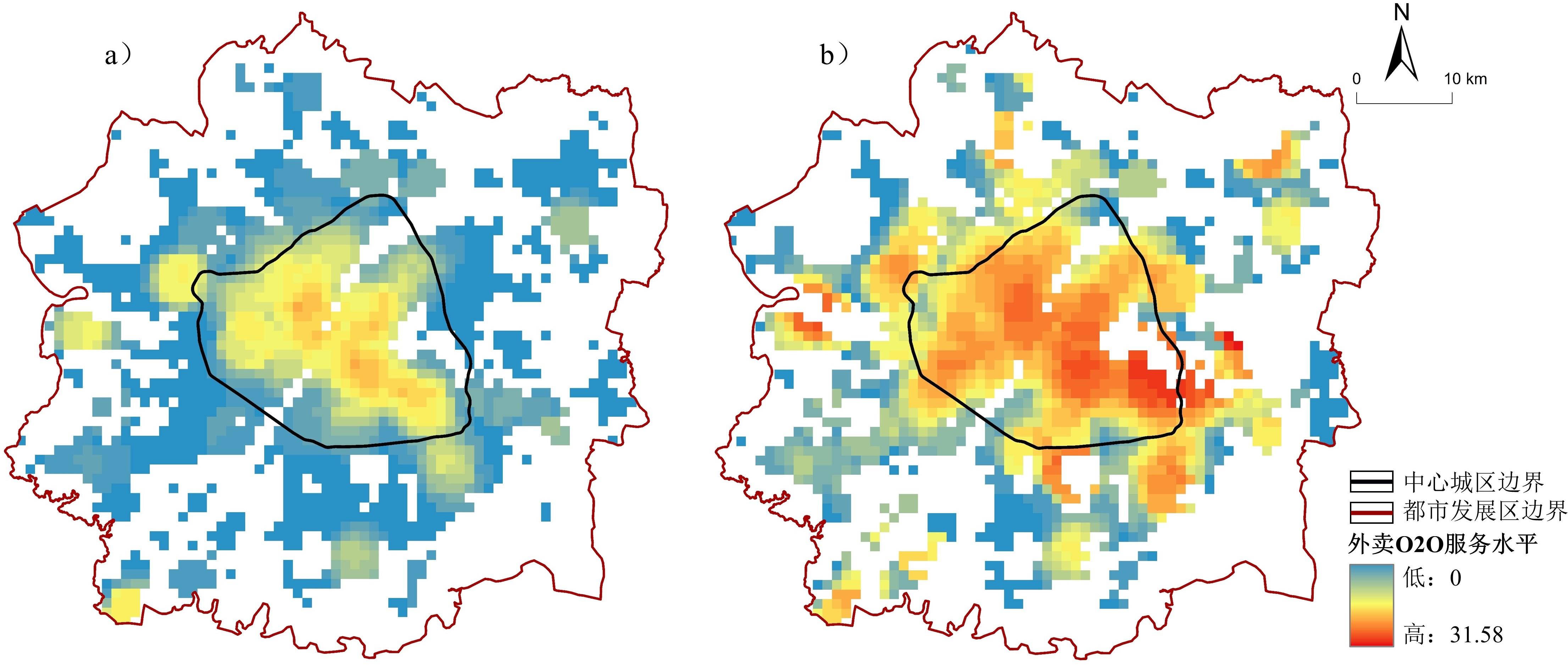 | |
| 传统 | 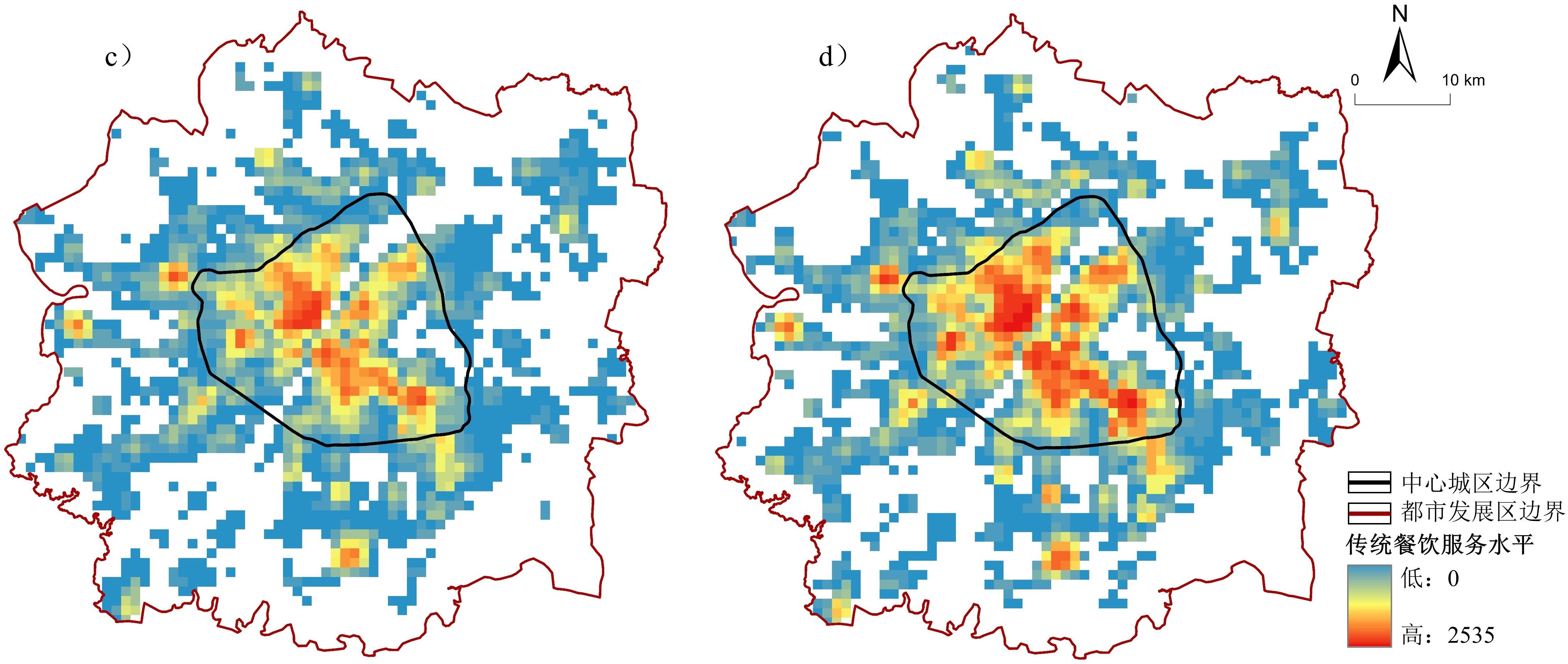 | |
图6 不同聚集区的外卖O2O与传统餐饮服务水平变化量Fig.6 The amount of change in the service level of take-out restaurant and traditional restaurant in different clusters |
图7 不同聚集区的人口及设施分布情况Fig.7 Distribution of population and facilities in different clusters |
表1 不同聚集区的典型地块分析Table 1 Analysis of typical plots in different clusters |
| 聚集区类型 | 区位 | 人口分布情况 | 设施分布情况 | 空间属性 | 主要结论 |
|---|---|---|---|---|---|
| 高-高 | 中心城区A1 |  | 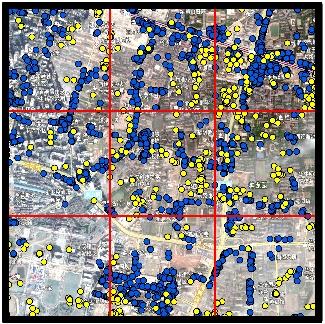 | 高密度居住建成区(南湖组团中部) | 位于人口密度高、外卖店铺与传统餐饮店数量均多的城区居住区 |
| 近郊区A2 | 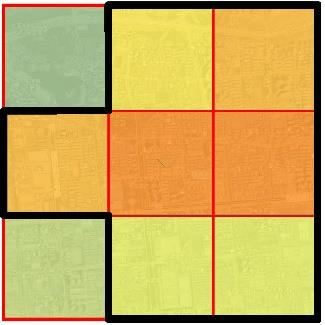 | 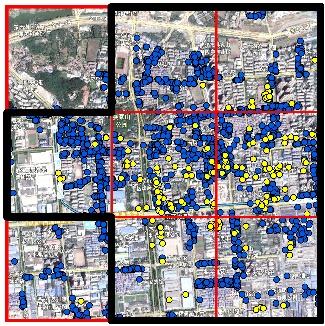 | 高密度居住建成区(吴家山) | 位于人口密度高、外卖店铺与传统餐饮店数量均多的近郊居住区 | |
| 低-低 | 中心城区B1 | — | — | — | — |
| 近郊区B2 | 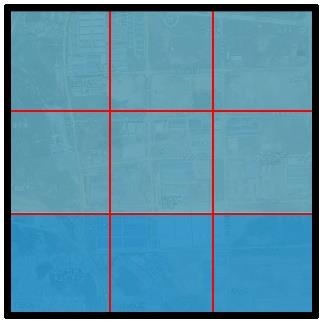 | 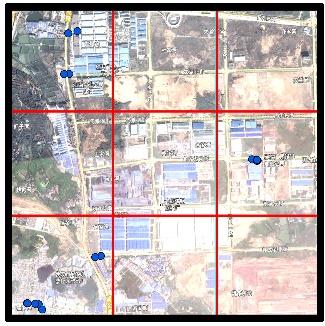 | 工业园区(南部新城组群西侧) | 位于人口密度低、仅存在少量传统餐饮店的近郊工业园区 | |
| 低-高 | 中心城区C1 | 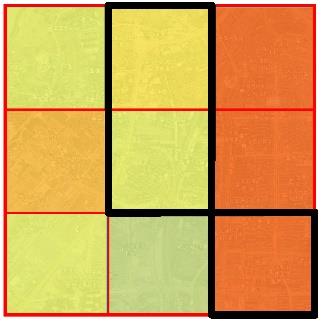 | 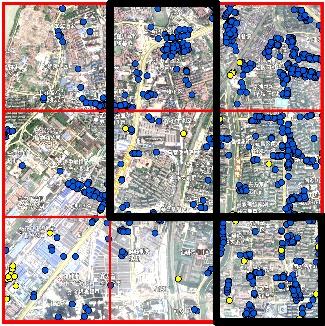 | 高密度居住建成区(南湖组团西侧) | 位于人口密度高、外卖店铺数量稀少、传统餐饮店数量多的城区居住区 |
| 近郊区C2 | 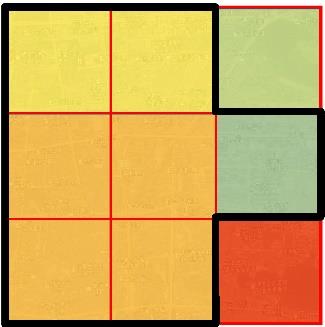 | 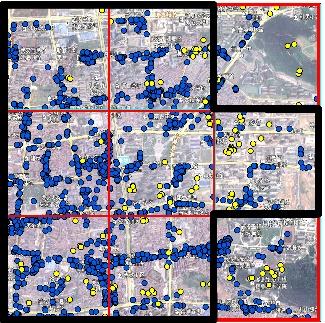 | 高密度居住建成区(纸坊新城) | 位于人口密度高、外卖店铺数量适中、传统餐饮店数量多的近郊居住区 | |
| 高-低 | 中心城区D1 | — | — | — | — |
| 近郊区D2 | 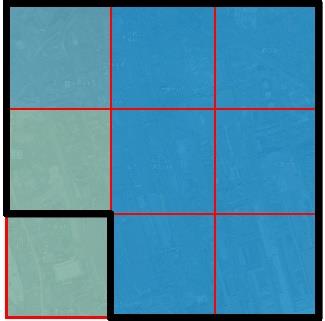 | 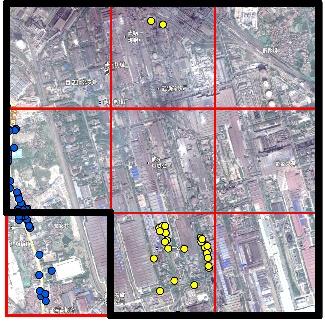 | 居住-工业 混合布局地区 (武钢组团南侧) | 位于人口密度低、外卖店铺数量较多、传统餐饮店数量较少的近郊居住-工业混合布局地区 | |
 | |||||

1 联通“智慧足迹”数据平台开放了基于联通全量手机用户信令数据通过大数据平台处理生成的用户驻留和出行位置数据,辅以用户入网基础属性和通信相关偏好属性,为全面进行人口分析提供决策支撑。
2 店铺送达时长主要包括商户出餐时间和实际配送时间,而商户出餐时间集中在10~15 min。具体可参见https://www.keloop.cn/information/art12372.html。
3 虽然江汉区、硚口区、汉阳区和武昌区也完全位于研究范围内,但区政府未公布当年餐饮业的营业额数据,因此未纳入相关性检验。
牛 强:提出研究思路,修订研究方案,修改论文,课题基金支持;
郭艺凯:论文撰写与修改,数据搜集与处理;
伍 磊:行文逻辑与理论梳理。
|
Anselin L, Syabri I, and Smirnov O. 2002. Visualizing Multivariate Spatial Correlation with Dynamically Linked Windows. In: Anselin L and Rey S. New Tools for Spatial Data Analysis: Proceedings of the Specialist Meeting. Santa Barbara: Center for Spatially Integrated Social Science, University of California.
|
|
艾媒咨询. 2019. 2018-2019中国在线外卖行业研究报告. (2019-04-30)[2022-06-25]. https://www.iimedia.cn/c400/64223.html.
IiMedia Research. 2019. 2018-2019 Research Report on China's Online Takeaway Industry. (2019-04-30) [2022-06-25]. https://www.iimedia.cn/c400/64223.html.
|
|
Cao X Y, Douma F, and Cleaveland F. 2010. Influence of E-shopping on Shopping Travel. Transportation Research Record Journal of the Transportation Research Board, 2157: 147-154.
|
|
Cao X J. 2012. The Relationships between E-Shopping and Store Shopping in the Shopping Process of Search Goods. Transportation Research Part A: Policy and Practice, 46(7): 993-1002.
|
|
曹劲舟,涂伟,李清泉,曹瑞. 2017. 基于大规模手机定位数据的群体活动时空特征分析. 地球信息科学学报,19(4):467-474.
Cao Jinzhou, Tu Wei, Li Qingquan, and Cao Rui. 2017. Spatio-Temporal Analysis of Aggregated Human Activities Based on Massive Mobile Phone Tracking Data. Journal of Geo-Information Science, 19(4): 467-474.
|
|
邓清华,薛德升,龚建周. 2019. 网购时代广州市居民购买食品行为特征. 热带地理,39(5):780-789.
Deng Qinghua, Xue Desheng, and Gong Jianzhou. 2019. Behavior Characteristics of Food Shopping of Guangzhou Residents in the Age of Online Shopping. Tropical Geography, 39(5): 780-789.
|
|
Farag S, Schwanen T, Dijst M, and Faber J. 2007. Shopping Online and/or In-store? A Structural Equation Model of the Relationships between E-Shopping and In-Store Shopping. Transportation Research A, 41(2): 125-141.
|
|
冯健,沈昕. 2021. 信息通讯技术(ICT)与城市地理研究综述. 人文地理,36(5):34-43,91.
Feng Jian and Shen Xin. 2021. A Review of Researches on Urban Geography Under the Background of Information and Communication Technology. Human Geography, 36(5): 34-43, 91.
|
|
Graham S and Marvin S. 1996. Telecommunications and the City: Electronic Spaces, Urban Places.London: Routledge.
|
|
Ganapathi R. 2015. A Study on Factors Affecting Online Shopping Behavior of Consumers in Chennai. Journal of Management Research and Analysis, 2(2): 123-126.
|
|
龚亚男,魏宗财,刘玉亭. 2021. 广州市保障房住区居民网购行为特征及其影响因素. 经济地理,41(4):74-81.
Gong Ya'nan, Wei Zongcai, and Liu Yuting. 2021. Online Consumption Behavior Characteristics of the Affordable Housing Residents and Their Influencing Factors in Guangzhou. Economic Geography, 41(4): 74-81.
|
|
胡志毅,张兆干. 2002. 城市饭店的空间布局分析——以南京市为例. 经济地理,22(1):106-110.
Hu Zhiyi and Zhang Zhaogan. 2002. An Analysis about the Spatial Distribution of Hotels in Urban Area: Taking Nanjing City as a Case. Economic Geography, 22(1): 106-110.
|
|
罗震东,毛茗,张佶,廖顺意,方鹏飞. 2022. 移动互联网时代城市新空间形成机制——以“外卖工厂”为例. 城市规划学刊,(4):64-70.
Luo Zhendong, Mao Ming, Zhang Ji, Liao Shunyi, and Fang Pengfei. 2022. Takeaway Factory: Formation Mechanism of New Urban Spaces in the Mobile Internet Era. Urban Planning Forum, (4): 64-70.
|
|
刘卫东,甄峰. 2004. 信息化对社会经济空间组织的影响研究. 地理学报,59(S1):67-76.
Liu Weidong and Zhen Feng. 2004. Spatial Implications of New Information and Communication Technologies. Acta Geographica Sinica, 59(S1): 67-76.
|
|
林玥希,汪明峰,马同翠. 2020. 网上购物对实体零售的影响——基于上海南方商城商业中心的调查. 世界地理研究,29(3):568-578.
Lin Yuexi, Wang Mingfeng, and Ma Tongcui. 2020. The Impact of Online Shopping on In-store Shopping: An Investigation of Nanfang Commercial Center in Shanghai. World Regional Studies, 29(3): 568-578.
|
|
刘学,甄峰,张敏,席广亮. 2015. 网上购物对个人出行与城市零售空间影响的研究进展及启示. 地理科学进展,34(1):48-54.
Liu Xue, Zhen Feng, Zhang Min, and Xi Guangliang. 2015. Research Review of Online Shopping Impact on Personal Travel and Urban Retail Space and Implications. Progress in Geography, 34(1): 48-54.
|
|
李靖华,曾锵. 2018. 商圈视角的网络购物对实体零售影响:替代抑或互补. 商业经济与管理,(4):5-15.
Li Jinghua and Zeng Qiang. 2018. The Research on the Influence of E-Shopping on In-Store Shopping from the Angle of Trading Area: Substitutes or Complements. Journal of Business Economics, (4): 5-15.
|
|
Mokhtarian P L, Salomon I, and Handy S L. 2006. The Impacts of ICT on Leisure Activities and Travel: A Conceptual Exploration. Transportation, 33(3): 263-289.
|
|
Muller C C and Inman C. 1994. The Geodemographics of Restaurant Development. Cornell Hotel and Restaurant Administration Quarterly, 35(3): 88-95.
|
|
Murphy A J. 2003. (Re)solving Space and Time: Fulfilment Issues in Online Grocery Retailing. Environment and Planning A, 35(7): 1173-1200.
|
|
美团研究院,中国饭店协会外卖专业委员会. 2020. 2019年及2020年上半年中国外卖产业发展报告. (2020-06-28)[2022-06-20]. https://mri.meituan.com/research/report.
Meituan Research Institute and China Restaurant Association Takeout Professional Committee. 2020. Report on the Development of China's Takeout Industry in 2019 and the First Half of 2020. (2020-06-28) [2022-06-20]. https://mri.meituan.com/research/report.
|
|
牛强,易帅,顾重泰,朱玉蓉,王盼. 2019. 面向线上线下社区生活圈的服务设施配套新理念新方法——以武汉市为例. 城市规划学刊,(6):81-86.
Niu Qiang, Yi Shuai, Gu Zhongtai, Zhu Yurong, and Wang Pan. 2019. New Concept and Approaches to the Reconfiguration of Service Facilities of Online and Offline Community Life Circle: A Case Study of Wuhan. Urban Planning Forum, (6): 81-86.
|
|
牛强,吴宛娴,伍磊. 2022. 信息时代城市活动与空间的演变与展望——基于线上线下的视角. 城市发展研究,29(10):96-106.
Niu Qiang, Wu Wanxian, and Wu Lei. 2022. Review and Prospect of the Evolution of Urban Activities and Space in the Information Age. Urban Development Studies, 29(10): 96-106.
|
|
Nikolaeva R. 2006. E-Commerce Adoption in the Retail Sector: Empirical Insights. International Journal of Retail & Distribution Management, 34(4/5): 369-387.
|
|
Nelson P. 1970. Information and Consumer Behavior. Journal of Political Economy, 78(2): 311-329.
|
|
Reigadinha T, Godinho P, and Dias J. 2017. Portuguese Food Retailers-Exploring Three Classic Theories of Retail Location. Journal of Retailing and Consumer Services, 34: 102-116.
|
|
施响,王士君,浩飞龙,王冬艳. 2021. 中国外卖O2O电子商务的空间扩散与渗透——兼论技术扩散假说与效率假说的适用性. 地理研究,40(5):1338-1353.
Shi Xiang, Wang Shijun, Hao Feilong, and Wang Dongyan. 2021. Spatial Diffusion and Penetration about the Takeaway O2O E-Commerce in China: Feasibility of Innovation Diffusion Hypothesis and Efficiency Hypothesis. Geographical Research, 40(5): 1338-1353.
|
|
宋正娜,陈雯,张桂香,张蕾. 2010. 公共服务设施空间可达性及其度量方法. 地理科学进展,29(10):1217-1224.
Song Zhengna, Chen Wen, Zhang Guixiang, and Zhang Lei. 2010. Spatial Accessibility to Public Service Facilities and Its Measurement Approaches. Progress in Geography, 29(10): 1217-1224.
|
|
宋周莺,虞洋,祝巧玲,车姝韵. 2019. 中国县域网络购物空间格局及其影响因素. 地理研究,38(12):2997-3009.
Song Zhouying, Yu Yang, Zhu Qiaoling, and Che Shuyun. 2019. Spatial Characteristics and Influencing Factors of E-Shopping Development in China's Counties. Geographical Research, 38(12): 2997-3009.
|
|
宋周莺,肖童. 2020. 空间因素在网络购物中的作用——基于广州市大学生网络购物的实证分析. 经济地理,40(8):18-26.
Song Zhouying and Xiao Tong. 2020. Dose Spatial Distance Factor Still Matter in Online Shopping Behavior: A Study of Undergraduates' Online Shopping in Guangzhou. Economic Geography, 40(8): 18-26.
|
|
舒舍玉,王润,孙艳伟,刘健,肖黎姗. 2012. 城市餐饮业的空间格局及影响因素分析——以厦门市为例. 热带地理,32(2):134-140.
Shu Sheyu, Wang Run, Sun Yanwei, Liu Jian, and Xiao Lishan. 2012. Spatial Distribution of Urban Catering Industry and Its Influenced Factors: A Case Study of Xiamen City. Tropical Geography, 32(2): 134-140.
|
|
史坤博,杨永春,杨欣傲,白硕,邵蕊,李博. 2016. 时间成本是否成为电子商务区位的核心机制——基于成都市O2O电子商务的实证分析. 地理学报,71(3):500-514.
Shi Kunbo, Yang Yongchun, Yang Xin'ao, Bai Shuo, Shao Rui, and Li Bo. 2016. Does Time Dictate the Location of E-Commerce Business? A Study of O2O Businesses in Chengdu, China. Acta Geographica Sinica, 71(3): 500-514.
|
|
孙智群,柴彦威,王冬根. 2009. 深圳市民网上购物行为的空间特征. 城市发展研究,16(6):106-112.
Sun Zhiqun, Chai Yanwei, and Wang Donggen. 2009. The Spatial Characteristics of E-Shopping Behavior of Shenzhen Residents. Urban Development Studies, 16(6): 106-112.
|
|
单卓然,张衔春,黄亚平. 2016. 武汉都市发展区及主城区城镇常住人口空间分布格局——基于2010年第六次人口普查数据. 人文地理,31(2):61-67.
Shan Zhuoran, Zhang Xianchun, and Huang Yaping. 2016. The Research on the Spatial Distribution Layout of City Permanent Residents in Metropolitan Development Area and Main Urban Area in Wuhan: Based on the Sixth Census in 2010. Human Geography, 31(2): 61-67.
|
|
汪明峰,卢姗,邱娟. 2010. 网上购物对城市零售业空间的影响:以书店为例. 经济地理,30(11):1835-1840,1896.
Wang Mingfeng, Lu Shan, and Qiu Juan. 2010. The Impact of Online Shopping on Urban Retail Space: A Case Study of Book Store. Economic Geography, 30(11): 1835-1840, 1896.
|
|
汪明峰,卢姗. 2012. 替代抑或补充:网上购物与传统购物出行的关系研究. 人文地理,27(3):44-49.
Wang Mingfeng and Lu Shan. 2012. Substitution or Complementation: Online Shopping and Its Relationship with Traditional Shopping Behavior. Human Geography, 27(3): 44-49.
|
|
汪明峰,卢姗,袁贺. 2013. 网上购物对不同区位消费者行为的影响——市区和郊区的比较. 城市规划,315(11):84-88,95.
Wang Mingfeng, Lu Shan, and Yuan He. 2013. Influences of Online Shopping on Consumer Behaviors at Different Shopping Locations: A Comparative Study on City Center and Suburb. City Planning Review, 315(11): 84-88, 95.
|
|
魏宗财,刘雨飞,彭丹丽. 2022. 疫情期潍坊市居民在线购物行为特征研究:与疫情前的对比. 人文地理,37(5):53-62.
Wei Zongcai, Liu Yufei, and Peng Danli. 2022. Characteristics of Residents' Online Shopping Behaviors in Weifang: Comparisons between COVID-19 Period and Normal. Human Geography, 37(5): 53-62.
|
|
王宇凡,林文盛,冯长春. 2019. 信息技术对城市生活服务业空间分布的影响——以北京网络外卖餐饮业为例. 城市发展研究,26(6):100-107.
Wang Yufan, Lin Wensheng, and Feng Changchun. 2019. The Impacts of Information and Communication Technologies on the Spatial Distribution of Urban Customer Services: A Case Study of Online Takeaway Industry in Beijing. Urban Development Studies, 26(6): 100-107.
|
|
Weltevreden J W. 2007. Substitution or Complementarity? How the Internet Changes City Centre Shopping. Journal of Retailing and Consumer Services, 14(3): 192-207.
|
|
武汉市人民政府. 2010. 武汉市城市总体规划(2010—2020年). (2011-11-30)[2022-05-16]. https://zrzyhgh.wuhan.gov.cn/xxfw/ghzs/202007/t20200707_1396424.shtml.
Wuhan Municipal People's Government. 2010. Wuhan Urban Master Plan (2010-2020). (2011-11-30) [2022-05-16]. https://zrzyhgh.wuhan.gov.cn/xxfw/ghzs/202007/t20200707_1396424.shtml.
|
|
武汉市人民政府. 2018. 武汉市城市总体规划(2017—2035年). 武汉:武汉市人民政府.
Wuhan Municipal People's Government. 2018. Wuhan Urban Master Plan (2017-2035). Wuhan: Wuhan Municipal People's Government.
|
|
武汉市自然资源和规划局. 2018. 建设“15分钟生活圈”实施行动指引. (2020-07-01)[2022-07-13]. https://www.wuhan.gov.cn/sy/whyw/202007/t20200701_1387619.shtml.
Wuhan Municipal Bureau of Natural Resources and Planning. 2018. Implementation Action Guidelines for Building a 15 Minute Life Circle. (2020-07-01) [2022-07-13]. https://www.wuhan.gov.cn/sy/whyw/202007/t20200701_1387619.shtml.
|
|
武汉市自然资源和规划局. 2021. 武汉市国土空间总体规划(2021—2035年). (2021-07-14)[2022-05-16]. https://www.wuhan.gov.cn/zwgk/wgk/jcgk/ygk/202107/t20210714_1738706.shtml.
Wuhan Municipal Bureau of Natural Resources and Planning. 2021. Overall Planning of Land and Space in Wuhan City (2021-2035). (2021-07-14) [2022-05-16]. https://www.wuhan.gov.cn/zwgk/wgk/jcgk/ygk/202107/t20210714_1738706.shtml.
|
|
武汉市统计局,国家统计局武汉调查队. 2019. 武汉统计年鉴2019. (2021-02-02)[2022-07-18]. https://tjj.wuhan.gov.cn/tjfw/tjnj/202102/t20210202_1624445.shtml.
Wuhan Municipal Statistics Bureau, and State Statistical Bureau Wuhan Investigation Team. 2019. Wuhan Statistical Yearbook (2019). (2021-02-02) [2022-07-18]. https://tjj.wuhan.gov.cn/tjfw/tjnj/202102/t20210202_1624445.shtml.
|
|
席广亮,甄峰,魏宗财,钱前. 2012. 南京市居民移动信息化水平及其影响因素研究. 经济地理,32(9):97-103.
Xi Guangliang, Zhen Feng, Wei Zongcai, and Qian Qian. 2012. Research on the Resident's Mobile Information Level and Its Influencing Factors in Nanjing. Economic Geography, 32(9): 97-103.
|
|
席广亮,甄峰,汪侠,秦萧. 2014. 南京市居民网络消费的影响因素及空间特征. 地理研究,33(2):284-295.
Xi Guangliang, Zhen Feng, Wang Xia, and Qin Xiao. 2014. Study on the Influencing Factors and Spatial Characteristic of Residents' Online Consumption in Nanjing. Geographical Research, 33(2): 284-295.
|
|
Xi G L, Cao X Y, and Zhen F. 2020. The Impacts of Same Day Delivery Online Shopping on Local Store Shopping in Nanjing, China. Transportation Research Part A: Policy and Practice, 136: 35-47.
|
|
晏龙旭. 2017. “均质化-再集聚”:互联网影响下餐饮业空间布局新特征——基于上海内环开放数据的研究. 城市规划学刊,(4):113-119.
Yan Longxu. 2017. The Impact of Online Take-Out Service on Restaurant Location Characteristics: A Study Based on Open Data in Shanghai Inner City. Urban Planning Forum, (4): 113-119.
|
|
袁海红,吴丹丹,马仁锋,金邑霞,张悦. 2018. 杭州文化创意产业集聚与城市建成环境场耦合性. 经济地理,38(11):123-132.
Yuan Haihong, Wu Dandan, Ma Renfeng, Jin Yixia, and Zhang Yue. 2018. Spatial-Correlation between Agglomeration of Cultural & Creative Industries and Urban Built Environment Field in Hangzhou. Economic Geography, 38(11): 123-132.
|
|
张永明,甄峰. 2017. 城市居民网络与实体购物互动模式及空间分异——以南京为例. 经济地理,37(1):15-22.
Zhang Yongming and Zhen Feng. 2017. The Interaction Mode between Online Shopping and Store Shopping of Urban Resident and Spatial Differentiation: A Case Study of Nanjing. Economic Geography, 37(1): 15-22.
|
|
翟青,高玉洁,魏宗财. 2020. 南京市线上-线下餐饮空间分布格局——以大众点评网和饿了么为例. 经济地理,40(12):119-127.
Zhai Qing, Gao Yujie, and Wei Zongcai. 2020. Spatial Pattern of Online and Offline Catering Service in Nanjing: A Case Study of Dianping and Eleme. Economic Geography, 40(12): 119-127.
|
|
甄峰. 2004. 信息时代新空间形态研究. 地理科学进展,23(3):16-26.
Zhen Feng. 2004. Researches on New Spatial Forms in Information Era. Progress in Geography, 23(3): 16-26.
|
|
甄峰,秦萧,席广亮. 2015. 信息时代的地理学与人文地理学创新. 地理科学,35(1):11-18.
Zhen Feng, Qin Xiao, and Xi Guangliang. 2015. The Innovation of Geography and Human Geography in the Information Era. Scientia Geographica Sinica, 35(1): 11-18.
|
|
张梦雨,王强,朱杰. 2022. 福州市外卖O2O与传统餐饮业空间分布特征及影响因素对比. 地理科学,42(8):1463-1473.
Zhang Mengyu, Wang Qiang, and Zhu Jie. 2022. Comparison of the Spatial Distribution and Influencing Factors of O2O Takeaway and Traditional Catering Industry in Fuzhou, China. Scientia Geographica Sinica, 42(8): 1463-1473.
|
|
Zhou Y W and Wang X K. 2014. Explore the Relationship between Online Shopping and Shopping Trips: An Analysis with the 2009 NHTS Data. Transportation Research Part A: Policy & Practice, 70: 1-9.
|
|
章雨晴,甄峰,张永明. 2016. 南京市居民网络购物行为特征——以书籍和衣服为例. 地理科学进展,35(4):476-486.
Zhang Yuqing, Zhen Feng, and Zhang Yongming. 2016. Characteristics of E-Shopping Behavior of Nanjing Residents: A Case of Books and Clothes. Progress in Geography, 35(4): 476-486.
|
|
周佼,林耿. 2021. 网络对实体店发展的影响——以广州市“网红咖啡店”为例. 现代城市研究,(2):114-120,125.
Zhou Jiao and Lin Geng. 2021. The Impact of the Internet on Physical Stores: A Case Study of Internet-Sensation Cafes in Guangzhou. Modern Urban Research, (2): 114-120, 125.
|
|
Zhai Q, Cao X Y, Mokhtarian P L, and Zhen F. 2017. The Interactions between E-Shopping and Store Shopping in the Shopping Process for Search Goods and Experience Goods. Transportation, 44(5): 885-904.
|
|
中国互联网络信息中心. 2022. 第49次中国互联网络发展状况统计报告. 北京:中国互联网络信息中心. [China Internet Network Information Center (CNNIC). The 49th China Statistical Report on Internet Development. Beijing: CNNIC. ]
|
/
| 〈 |
|
〉 |